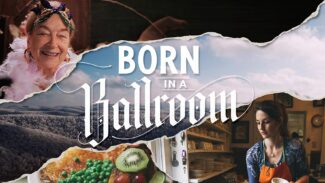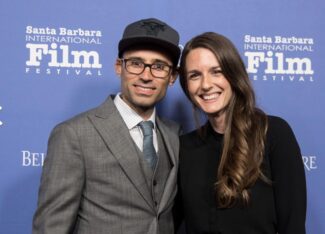Born in the Ballroom (Jonathan Lacocque and Clara Lehmann, 2020): United States
Reviewed by Justin Tuttle. Viewed at the Santa Barbara International Film Festival 2020.
 Played to a packed house for it’s World Premier, Born in the Ballroom was my favorite film at the Santa Barbara International Film Festival (SBIFF) 2020. It was a moving, touching, beautifully and professionally crafted film about a special matriarch, Eleanor Mailloux (affectionally called Mütter) and the lives she touched of those around her. Born in a Ballroom was directed and written by Jonathan Lacocque and Clara Lehmann. Clara Lehmann also appears in the movie as an actress, as Mütter is her late grandmother.
Played to a packed house for it’s World Premier, Born in the Ballroom was my favorite film at the Santa Barbara International Film Festival (SBIFF) 2020. It was a moving, touching, beautifully and professionally crafted film about a special matriarch, Eleanor Mailloux (affectionally called Mütter) and the lives she touched of those around her. Born in a Ballroom was directed and written by Jonathan Lacocque and Clara Lehmann. Clara Lehmann also appears in the movie as an actress, as Mütter is her late grandmother.
Set in the small Appalachian town of Helvetia, West Virginia (population 59), the movie centers around The Hütte, a restaurant that Eleanor Mailloux (hereinafter Mütter) founded. Helvetia was settled by Swiss immigrants and still to this day carries on many traditions brought over from Switzerland. The Hütte incorporates many authentic recipes which draws guests to the restaurant from far and wide to the restaurant. Mütter’s family home caught on fire the night she was born. Her family found shelter in a neighbor’s home and she was “born in the ballroom” of that home. In a way, her interesting birth story emulates the interesting life she was to lead.
Through the adept use of old photographs, vintage film, interviews of family and townspeople, and footage taken during the working restaurant, filmmakers Jonathan Lacoque and Clara Lehmann weave together a film that by the end makes you feel closely connected to Mütter as if she was your own special grandmother and her family as if they were your own. The filmmakers used special touches to create an inviting feel that draws you into the film. For instance, when showing vintage film, they used an old Zenith TV framed by books and an antique bottle to make it appear one was watching through that TV. The filmmakers took special care during interviews to not only draw out and edit in meaningful dialogue, they used depth of field techniques to subtly blur the backgrounds out to keep the focus of attention on the subject. I found that other techniques such as filming an image reflected off a mirror differentiated the movie from other documentaries giving it a more dramatic feature film feel. It is also noteworthy to mention that the filmmakers used different visual cues to note different moments of the story. For instance, during a scene when Clara is recounting Mütter’s death, there is footage taken down low from blades of grass up to the sky as well as footage of fog hanging over the valley and town. Combined with those subtle cues of passing time coupled with Clara’s words tugged at the movie viewers heart strings. When Clara cried, some of those in the audience also cried.
I had the chance to listen to Jonathan Lacocque and Clara Lehmann share about their story and professional background during a SBIFF filmmakers panel as well as a post viewing Question and Answer session. I have a feeling we will be seeing more from them in the years to come.
I highly recommend this film and hope it is released to a wider audience so that more moviegoers can feel a part of this story and see the work of such up and coming filmmakers.
About this entry
You’re currently reading “Born in the Ballroom (Jonathan Lacocque and Clara Lehmann, 2020): United States,” an entry on Student Film Reviews
- Published:
- 01.30.20 / 7pm
- Category:
- Documentary, Films, Santa Barbara Film Festival 2020

1 Comment
Jump to comment form | comments rss [?]